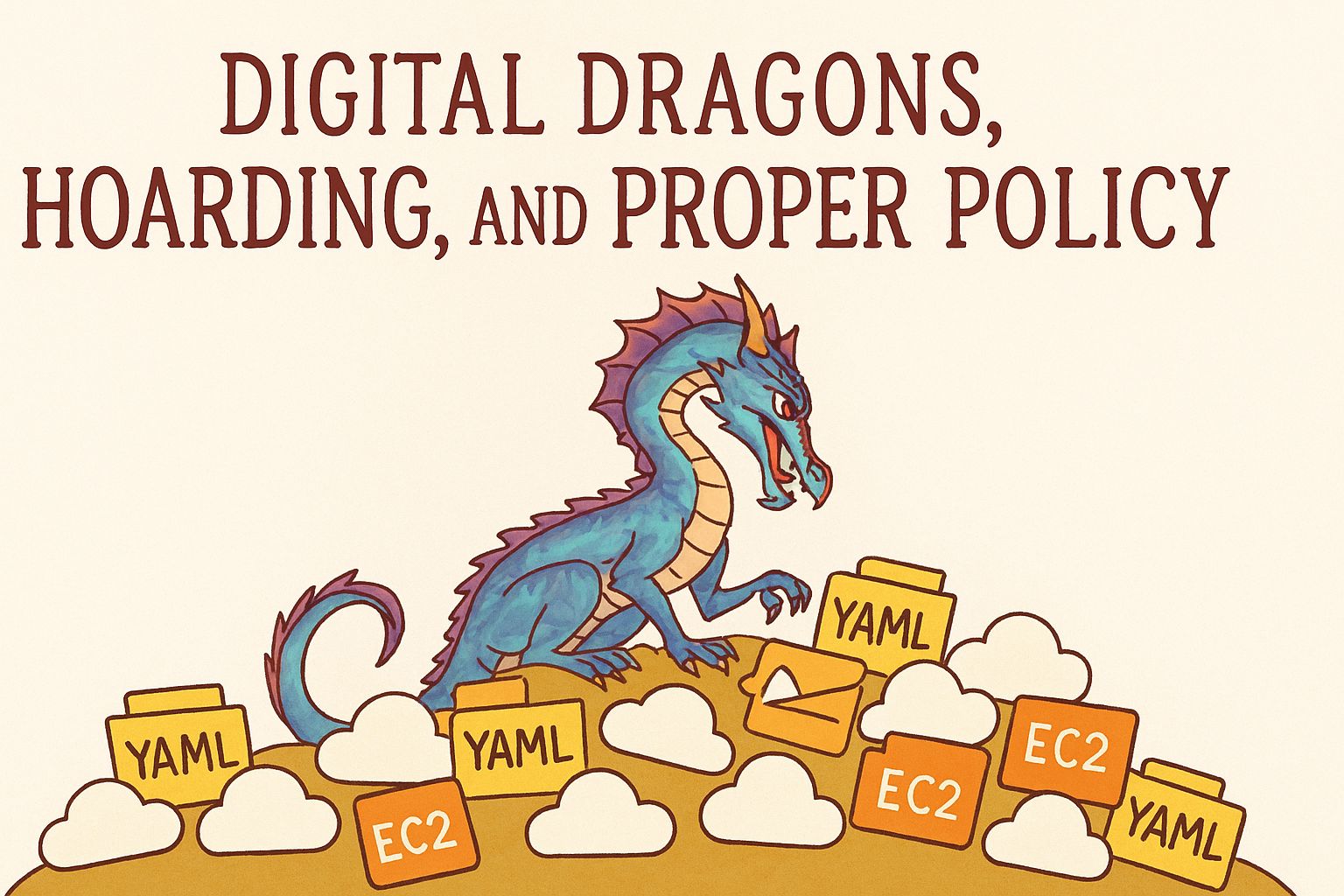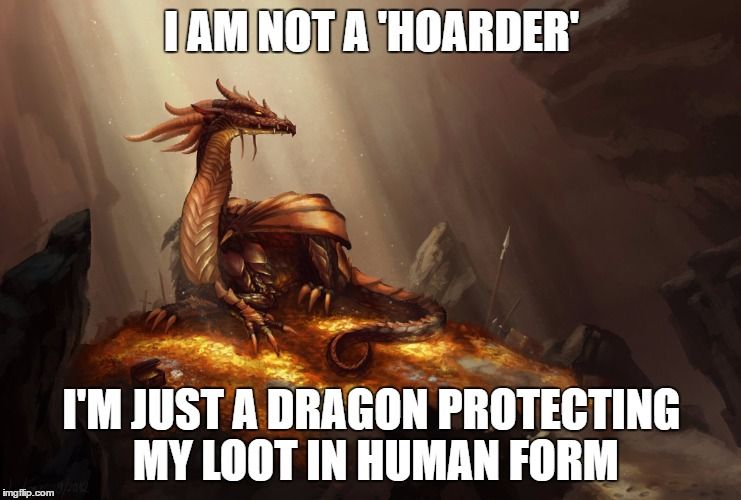
Digital Dragons: Hoarding, FinOps, and the Cost of Forgotten Treasure
How teams accumulate cloud clutter, and how to build a simple, cyclical loop to audit, discuss, deprecate, and delete your digital hoard — turning chaos into clarity with FinOps thinking.
- “I don’t want to delete that folder — it might have an OS copy I need later.”
- “I don’t want to take down this EC2 instance — what if someone needs to connect to it?”
- “There are three years of snapshots... we might use them all someday.”
- “Hey, that old database we haven’t touched in four years might have valuable insights in it.”
If any of these sound familiar, congratulations — you may have a digital dragon problem.
I’ve heard these phrases in more technology departments than I can count. In truth, I’ve said some of them myself.
I’m the kind of person who has 40 GB of eBooks on technology that are super important and can never, ever, ever be deleted.
This is my pile of digital gold, and none of you will touch it!
The difference now is that my hoard doesn’t live on a one-time-purchase hard drive under my desk — it’s in the cloud, which means every gigabyte I cling to has a real, persistent cost.
That’s fine for one person. But multiply that mindset across an entire company, and you end up with a mountain of forgotten files, idle EC2 instances, and mysterious storage buckets — all quietly burning money.
How the Hoard Happens

It’s easy to see how we got here.
- Your development team builds and deploys.
- Your QA team tests and validates.
- Your product team keeps clients happy and roadmaps current.
But whose job is it to review the environments where code is compiled, where applications are deployed, or where that “temporary” high-CPU VM still hums months later?
The honest answer: probably no one’s.
And if it’s not measured, it doesn’t get managed — at least not until the cloud bill starts to rise and someone finally asks, “What is all this?”
Look at What’s in the Hoard
Someone needs to own the hoard.
Someone needs to know what’s in it, decide what’s worth keeping, and store or delete the rest.
Recently, we worked with a client’s development team and, in just six weeks, cut their operating costs by over 50%.
How?
We audited their digital treasure pile, asked the dragons guarding it which artifacts still mattered, and moved the truly valuable items into proper long-term storage.
Because it was someone’s explicit job — and it was measured — the results were immediate and dramatic.
How to Start Taming Your Hoard
Taming your company’s digital dragon doesn’t mean slaying it; it means understanding it.
This isn’t a high-stakes quest with fire and brimstone; it’s more like tidying your digital attic, one shelf at a time.
The trick is to make this work cyclical — something that happens naturally as part of your team’s rhythm.
You audit, discuss, deprecate, and delete — then you come back around to audit again.
It’s a loop, not a one-time cleanup.
Audit — Know What’s in the Hoard
Start by looking around. What’s running? What’s idle? What’s duplicated?
You don’t need fancy tooling to begin. A spreadsheet or a shared doc works fine. The goal is visibility.
Think of it like wandering through your dragon’s cave with a lantern — you’re just taking notes.
Ask simple questions:
- What workloads are still active?
- Which environments are no longer in use?
- Are there old EC2 instances, RDS snapshots, or S3 buckets serving no one?
At this stage, don’t delete anything. Just observe and document.
You’re building a map of your treasure pile.
Discuss — Talk to the Dragons
Now that you know what’s there, talk to the people who created it. Developers, QA, data analysts — each has their own little treasure mound.
Ask:
- Why does this exist?
- Who uses it today?
- When was it last needed?
You’ll be surprised how often someone says, “Oh, I thought we deleted that,” or “That was from a demo in 2022.”
These conversations are key — they help you separate gold from gravel.
And they’re a great way to re-engage teams in ownership of their cloud spaces without turning it into blame or bureaucracy.
Deprecate — Move It to the Vault
Once you’ve identified what’s still valuable but not actively needed, move it somewhere appropriate.
Deprecation is about right-sizing, not destroying.
- Move snapshots to cheaper storage tiers.
- Archive old builds.
- Tag them with expiration dates.
Set a clear rule for how long something stays in this state. Maybe it’s 90 days, maybe 6 months — just make sure it’s written down and agreed on.
The power here is in consistency. You’re saying, “This is how we treat artifacts from past projects,” and then doing it every time.
Delete — Let Go of Old Bones
This is the hardest part.
At some point, every hoard has things that are simply… bones.
The old dev VM that hasn’t been powered on since 2021. The 400GB of logs that no one reads. The proof-of-concept that turned into a fossil.
Create a clear deletion policy:
- What qualifies for deletion?
- Who approves it?
- How often will we purge?
Once something meets your defined criteria — delete it confidently.
You’ll instantly feel the benefit on your bill and in your sanity.
Keep the Loop Going
The important thing is to treat this as a loop, not a cleanup event.
At Cloudloop, we literally think in loops — so this should feel familiar. After “Delete,” you start again at “Audit.”
Maybe you run it quarterly, maybe twice a year. The point is to bake the habit in.
Over time, your environment stays clean, predictable, and cost-efficient without heroic effort.
It’s not about perfection — it’s about rhythm.
Keep the dragons fed, but don’t let them drown in their own treasure.
The FinOps Connection
What you’re really building here is the foundation of a FinOps practice — even if you don’t call it that yet.
FinOps is about aligning cloud usage with real business value.
It’s the blend of visibility, collaboration, and iteration that lets you make data-driven decisions about what’s worth keeping and what’s just smoke from an old fire.
When teams can see what they’re spending, talk openly about why it exists, and act on a shared policy for cleanup, cost optimization stops being a reaction to a scary bill — it becomes part of the way you work.
That’s the magic of a Cloudloop: helping teams turn chaos into clarity, one hoard at a time.